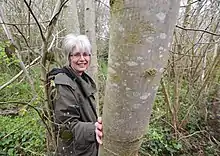
Anne Edwards is a British plant scientist, based at the John Innes Centre and was the first person in the UK to identify Ash dieback disease in England,[1][2][3][4]
Ash dieback
Edwards was the first person to identify Ash Dieback, caused by the fungus Hymenoscyphus fraxineus, discovering it in Ashwellthorpe Woods, Norfolk in 2012.[5][6] Four years later she found a tree that was resistant to the disease and named it Betty which was used to help identify three genetic markers associated with resistance against the disease.[7][8][9][10][11] Anne is heavily involved in the Nornex consortium, an open-access and crowdsourcing approach,[12] which was established to respond to this outbreak. This involved creating a game, Fraxinus, where players analyse real data.[13] She continues to play an active role in researching the disease, for example in estimating the mortality of trees it infects[14] and tracing back how the fungus entered the country from just one or two fruiting bodies.[15]
Grasspea
During her career Edwards has also worked on grass pea (Lathyrus sativus), one of the oldest known crops, native to southern and eastern Europe, Ethiopia, India, Bangladesh and Nepal. Grass pea is a key food source and is extremely drought and flood resistant. It has a very high protein content and as a nodulating legume it requires no artificial fertiliser so can grow on, and improve, the poorest of soils. However, grass pea produces a toxin that can cause irreversible paralysis if it is consumed as the main food source over several months.[16] As such, with Cathie Martin, Edwards is working to develop safe varieties that can be used by smallholder farmers.[17]
Outreach
In 2015 Edwards was awarded the British Empire Medal for services to the environment and the public understanding of science, for her discovery and work on the disease, plus her scientific communication outreach work.[18][19]
References
- ↑ Knapton, Sarah (2016-04-22). "Oooh Betty! How a 200-year-old ash tree is saving British woodland". The Telegraph. ISSN 0307-1235. Retrieved 2019-03-07.
- ↑ Staff (2017-02-21). "Ash dieback disease: a plague on our ashes". POnTE Project. Retrieved 2019-02-27.
- ↑ "Ash Dieback". John Innes Centre. Retrieved 2019-02-27.
- ↑ Barkham, Patrick (2016-04-22). "'Betty' the ash tree offers hope against deadly dieback disease". The Guardian. Retrieved 2019-02-27.
- ↑ Dickson, Annabelle. "Norfolk ash tree fights off dieback disease giving hope to our woodlands". Eastern Daily Press. Retrieved 2019-03-07.
- ↑ "Anne Edwards showing Julian Rush the signs of Ash Dieback - Exploring Britain's Tree Disease Problem - Future-proofing Forests, Costing the Earth - BBC Radio 4". BBC. Retrieved 2019-03-07.
- ↑ Barkham, Patrick (2016-04-22). "'Betty' the ash tree offers hope against deadly dieback disease". The Guardian. ISSN 0261-3077. Retrieved 2019-03-07.
- ↑ Knapton, Sarah (2016-04-22). "Oooh Betty! How a 200-year-old ash tree is saving British woodland". The Telegraph. ISSN 0307-1235. Retrieved 2019-03-07.
- ↑ "The Tree Council > Press & News > New research offers hope on ash dieback". www.treecouncil.org.uk. Retrieved 2019-03-07.
- ↑ "Genetic secrets of resistant tree gives new hope over ash dieback". The Independent. 2013-06-16. Archived from the original on 2022-05-07. Retrieved 2019-03-07.
- ↑ Downie, Allan; Edwards, Anne (7 October 2013). "We must develop the genetic tools to fight ash dieback". The Conversation. Retrieved 2019-03-07.
- ↑ Rallapalli, Ghanasyam; Fraxinus Players; Saunders, Diane GO; Yoshida, Kentaro; Edwards, Anne; Lugo, Carlos A; Collin, Steve; Clavijo, Bernardo; Corpas, Manuel (2015-07-29). Rodgers, Peter (ed.). "Lessons from Fraxinus, a crowd-sourced citizen science game in genomics". eLife. 4: e07460. doi:10.7554/eLife.07460. ISSN 2050-084X. PMC 4517073. PMID 26219214.
- ↑ "ash dieback fight-back: new Facebook game | Science Media Centre". Retrieved 2019-03-07.
- ↑ Coker, Tim L. R.; Rozsypálek, Jiří; Edwards, Anne; Harwood, Tony P.; Butfoy, Louise; Buggs, Richard J. A. (2019). "Estimating mortality rates of European ash (Fraxinus excelsior) under the ash dieback (Hymenoscyphus fraxineus) epidemic". Plants, People, Planet. 1 (1): 48–58. doi:10.1002/ppp3.11. ISSN 2572-2611.
- ↑ "Just one more ash dieback spore could push European ash trees to the brink". ScienceDaily. Retrieved 2019-03-07.
- ↑ Brown, David (2018-10-01). "The poison peas that could soon be a superfood". The Times. ISSN 0140-0460. Retrieved 2019-03-07.
- ↑ Jackson, Mike (2018-10-12). "Whither the grasspea?". A balanced diet . . . Retrieved 2019-03-07.
- ↑ Hill, Chris (3 January 2015). "John Innes Centre scientist awarded British Empire Medal for her work on ash dieback disease". Eastern Daily Press. Retrieved 2019-03-07.
- ↑ Baldwin, Louisa (10 May 2017). "Someone call Professor Sprout! Harry Potter's poisonous 'screaming mandrakes' found at Walsingham allotment". North Norfolk News. Retrieved 2019-03-07.